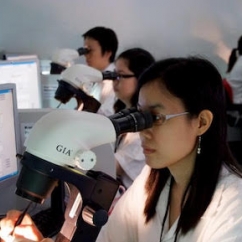Articles and News
GIA to Report Color and Clarity Grades for Lab-Grown Diamonds August 12, 2020 (0 comments)

Carlsbad, CA—GIA (Gemological Institute of America) will begin reporting specific 4Cs color and clarity grades on its new digital reports for laboratory-grown diamonds, replacing the currently-used descriptive terms and grade ranges.
Launching early in the fourth quarter, the new service for laboratory-grown diamonds will include the GIA Laboratory-Grown Diamond Grading Report (4Cs assessment, plotted clarity diagram and proportions diagram) for stones from 0.15 carats up, and the lower-priced Laboratory-Grown Diamond Dossier (4Cs assessment and proportions diagram) for stones from 0.15 carats up to 1.99 carats. The GIA Laboratory-Grown Colored Diamond Grading Report will also include the specific color and clarity grade. All laboratory-grown diamonds will be laser-inscribed with the GIA report number and the words "LABORATORY-GROWN" to ensure that consumers can clearly differentiate the product and fully understand their purchases.
“Natural and laboratory-grown diamonds coexist today, accepted by both consumers and the trade. We believe the growth of laboratory-grown diamonds will expand the overall diamond market and bring in new customers,” said Susan Jacques, GIA president and CEO. “Ensuring consumers’ trust with GIA’s reliable, independent and authoritative grading reports for all diamonds benefits the public and the entire gem and jewelry industry.”
Fees for the new laboratory-grown diamond grading services will be the same as the current fees for natural diamond grading services, as the grading work is the same. The new reports will be digital-only, featuring an updated design and format to differentiate from GIA’s reports for natural diamonds. All reports for laboratory-grown diamonds will continue to carry a statement that the graded stone may have been treated post-growth to change its color.
“Reporting the color and clarity grades of laboratory-grown diamonds using GIA’s universally recognized 4Cs system will provide more precision for the trade, and will educate consumers,” said Tom Moses, GIA executive vice president and chief laboratory and research officer.
GIA has offered a report service for laboratory-grown diamonds since 2007, but in March 2019, changed how it refers to laboratory-grown diamonds in its education course materials and diamond grading reports, to align with revised Federal Trade Commission guidance.







